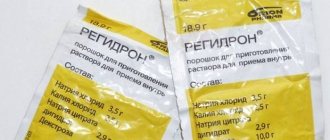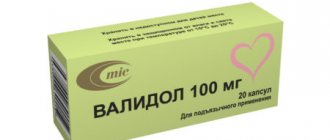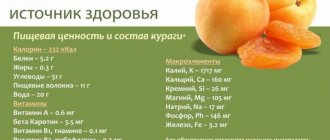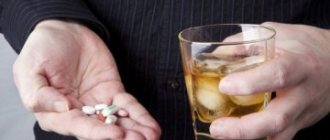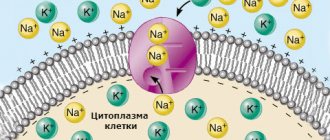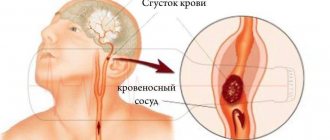Composition and release form
The drug is produced in two dosage forms: white biconvex tablets and a solution for intramuscular or intravenous infusion (5 mg of active ingredient in 2 ml). The composition of the tablets is presented in the table:
| Compound | Weight, mg |
| Active ingredient: Lappaconitine hydrobromide | 25 |
| Auxiliary components: | |
| Potato starch | 7,5 |
| Calcium stearate | 1 |
| Croscarmellose sodium | 1 |
| Sucrose, galactose | 65,5 |
Special instructions for the use of the drug Sotahexal
Treatment with sotalol is carried out under the control of heart rate, blood pressure, and ECG. Constant medical monitoring of patients is necessary in the following cases:
- in case of renal failure (it is necessary to monitor the concentrations of creatinine and sotalol hydrochloride in the blood serum at certain intervals);
- in diabetes mellitus with significant fluctuations in blood glucose levels, while the symptoms of hypoglycemia can be masked (it is necessary to monitor the concentration of glucose in the blood);
- while following strict diets;
- with hyperthyroidism (in this case, adrenergic symptoms can be masked);
- in case of peripheral perfusion disorders;
- for pheochromocytoma (the drug can be used only after blockade of α-adrenergic receptors).
During the period of use of sotalol, patients who have suffered a myocardial infarction or patients with impaired myocardial contractility should be under the supervision of a cardiologist. When discontinuing the drug, the dose is reduced gradually; Particular care is taken when stopping treatment in patients with coronary artery disease and cardiac arrhythmias, as well as after prolonged use of the drug. The question of discontinuing or changing the dosage regimen of the drug in patients with life-threatening cardiac arrhythmias can only be decided by a doctor. Sotalol may increase sensitivity to allergens and increase the severity of anaphylactic reactions, which must be taken into account when treating patients with a history of severe hypersensitivity reactions and those on desensitization therapy. Severe proarrhythmia (sustained ventricular tachycardia, ventricular flutter/fibrillation), predominantly dose-dependent, is noted mainly at the beginning of therapy, as well as with increasing doses of the drug. In cases of severe diarrhea or concomitant use of drugs that cause loss of magnesium and/or potassium, it is necessary to monitor the electrolyte balance and acid-base balance
Since sotalol hydrochloride is found in urine, photometric determination of metanephrine may result in overestimated values. In patients who have taken sotalol, as well as with suspected pheochromocytoma, the determination of metanephrine in urine should be carried out using the HPLC method with solid phase extraction. When treating elderly patients, possible renal failure must be taken into account and appropriate dose adjustments must be made. Pregnancy and lactation Since experience There is no use of sotalol during pregnancy; the drug can be prescribed during this period only with an accurate diagnosis and absolute indications for its use. It must be taken into account that sotalol hydrochloride crosses the placenta and reaches pharmacologically active concentrations in fetal tissues, as a result of which the fetus or infant may develop undesirable effects such as bradycardia, hypotension and hypoglycemia. For this reason, therapy should be interrupted 48–72 hours before the expected date of birth. After birth, the child must be closely monitored for some time (beta receptor blockade may develop). Breastfeeding should be stopped during treatment with the drug. Effects on the ability to drive vehicles and other mechanisms The drug can change the body's reaction rate, which affects the ability to drive vehicles and other mechanisms, especially at the beginning of treatment.
Properties of the drug
Allapinin tablets contain the hydrobromic salt of the alkaloid lappaconitine with alkaloids of the white-mouthed grass, rhizomes and roots of the northern (high) wrestler from the Ranunculaceae family.
This is a first class antiarrhythmic drug. The drug has antispasmodic, anticholinergic, coronary dilator, sedative and local anesthetic effects.
When taking tablets, the effect is visible after 50 minutes, manifests itself after a maximum of 4.5 hours, and lasts over 8 hours. The active component has 40% bioavailability. The drug penetrates the blood-brain barrier; with prolonged use, its half-life is prolonged, as in chronic renal failure or cirrhosis of the liver.
Which is better - Cordarone or Sotahexal?
In some cases, doctors may prescribe Cordarone or Sotahexal - which one is better to choose? The formulation of this question is somewhat incorrect - you cannot choose just one drug from these medications - Sotahexal or Cordarone. There are situations when, according to the instructions, it is necessary to take both of these drugs at once so that they complement each other’s action. Indications for the combined use of Sotahexal and Cordarone:
- prevention of atrial fibrillation;
- treatment of refractory ventricular extrasystole.
Some studies have noted that when cordarone is ineffective, adding a beta blocker even at half the dosage can achieve a therapeutic effect.
It is worth noting that Cordarone, according to the instructions, belongs to a later generation of antiarrhythmic drugs; it realizes its effect through several mechanisms:
- stabilization of cell membranes responsible for excitation;
- partial blockade of calcium channels;
- inhibition of potassium channels.
Due to the wider range of actions described in the instructions, the use of cordarone is considered more effective compared to Sotahexal. However, it also has disadvantages, for example, its use, according to the instructions, is contraindicated in patients with concomitant pathology of the thyroid gland, since it contains iodine.
Directions for use and dosage
For tablets, the standard dosage regimen is according to the manufacturer's instructions: 0.025 g every 8 hours. If there is no result, the single dosage is increased (maximum - 0.05 g), and the frequency is reduced to 6 hours. The maximum daily dose is 0.3 g, single dose is 0.05 g.
For intravenous or intramuscular infusion, the drug is diluted with sodium chloride. Intramuscular administration is carried out every 6 hours, dosage – 0.4 mg/kg. Intravenous at the same interval of 0.3-0.4 mg/kg, lasting 5 minutes. The repeat dose is 0.3 mg/kg and is administered as needed after 6 hours.
How long can you take Allapinin
The duration of therapy is determined by the general condition of the patient, the degree of cardiac arrhythmia and can last several months. When taken orally, the drug begins to act in about an hour, the effect lasts about 8 hours. When used as infusions, the effect begins after 15-20 minutes and lasts 6-8 hours.
Articles on the topic
- Amprilan - instructions for use, dosage, contraindications, analogues and price
- Gayro - instructions for use of the drug
- Gastrocepin - instructions for use, contraindications, composition and release form
During pregnancy and lactation
Before taking the medication, pregnancy must be excluded; use during pregnancy is strictly contraindicated. Can only be used in the first trimester under strict prescriptions. The effects on the fetus have not been sufficiently studied. It is possible that the main pharmaceutical substances are able to penetrate the blood-milk barrier. The medication cannot be used during breastfeeding, as the composition of human milk may change.
In the first trimester of pregnancy, it is possible for strict medical reasons, with a careful analysis of all risk factors. Breastfeeding should be stopped during treatment.
Prescription of Sotahexal during pregnancy, especially in the first trimester, is possible solely for health reasons.
In case of treatment during pregnancy, the drug should be stopped 48-72 hours before the expected onset of labor, due to the possible development of hypokalemia, arterial hypotension, bradycardia and respiratory depression in the newborn.
If it is necessary to use the drug Sotahexal during lactation, breastfeeding should be stopped.
Overdose
The limited range of therapeutic effects contributes to the development of intoxication. This risk especially increases when combined with other antiarrhythmic drugs. To overcome the condition, symptomatic treatment is prescribed. When treating ventricular tachycardia, antiarrhythmic drugs are used. For bradycardia and arterial hypotension, the administration of sodium bicarbonate helps. Overdose symptoms:
- clouding of consciousness;
- gastrointestinal disorder;
- drop in blood pressure;
- decreased myocardial contractility;
- bradycardia;
- asystole;
- paroxysm of ventricular polymorphic tachycardia.
Side effects
Sotahexal (SotaHEXAL) may cause side effects. These instructions include:
- angina pectoris, bradycardia, decreased blood pressure, shortness of breath, arrhythmia, edema, AV block;
- flatulence, nausea, dry mouth, diarrhea;
- headache, paresthesia, dizziness, depression, fatigue, drowsiness, depression, insomnia, anxiety, tremor, asthenia;
- impaired vision, hearing, taste, inflammation of the cornea, conjunctiva;
- skin rash, urticaria, itching, alopecia, redness of the skin, dermatosis due to the influence of allergens, gangrene of the extremities;
- increased results in photometric urine analysis for metanephrine (methyladrenaline);
- convulsive syndrome.
Contraindications
The reasons for prohibiting the use of the drug are the following conditions:
- sinoatrial block;
- AV block of the second or third degree (without an installed artificial pacemaker);
- severe impairment of the kidneys and liver;
- simultaneous blockade of one of the branches of the left part of the His bundle and the right part;
- post-infarction cardiosclerosis;
- severe hypertrophy of the left ventricular muscle (wall thickness more than 1.4 cm);
- allergic reaction to the components of the drug.
Allapinin is prescribed with caution and under the supervision of a doctor for the following conditions:
- 1st degree AV block;
- severe pathologies of peripheral circulation;
- prostate hypertrophy;
- intraventricular conduction dysfunction;
- angle-closure glaucoma;
- weakness of the sinus node;
- bradycardia;
- electrolyte metabolism disorder;
- deterioration of the conductivity of Purkinje fibers;
- combination with other antiarrhythmic drugs.
What does it help with?
Supraventricular arrhythmias are an absolute indication for the use of sotalol, part of Sotahexal. What does this drug help with according to the instructions:
- fibrillation (chaotic contraction of the atria);
- heart flutter (atrial contraction with a frequency of over 200 beats per minute);
- Wolff-Parkinson-White syndrome, in which rhythm disturbances are periodic;
- ventricular tachycardia - a condition in which the pacemaker is the ventricles of the heart, and not the sinoatrial node;
- ventricular extrasystoles are extraordinary contractions of the heart that disrupt the normal functioning of the heart.
Normal and atrial fibrillation
Allapinin's analogues
You can replace the drug Allapinin with drugs with a similar effect, the same or a different composition. These include:
- Propanorm, Ritmonorm, Propafenone - tablets based on propafenone.
- Ethacizine - tablets containing diethylaminopropionylethoxycarbonylaminophenothiazine hydrochloride.
Description and instructions for the drug Allapinin
Allapinin is a drug that is used for heart pathologies. The active substance of the drug is also called allapinin. This substance affects the conduction of nerve impulses in the heart, blocking the so-called “fast sodium channels”. This treatment relieves arrhythmic attacks. At the same time, if there are no symptoms of heart failure, then the main parameters of the heart - QT interval, heart rate, pressure - do not change. In addition, Allapinin has moderate effects: sedative, analgesic, antispasmodic. After using a dose of the drug, its effect is felt after about an hour. And after an hour and a half, the maximum effect is achieved.
Price
You can buy the drug Allapinin through pharmacies or the Internet. Approximate prices in Moscow:
| Type of medicine | Pharmacy | Price, rubles |
| 30 tablets 25 mg | Dialogue | 546 |
| Help window | 656 | |
| Gorzdrav | 592 | |
| 36,6 | 588 | |
| Ver.ru | 576 | |
| Laboratory of Beauty and Health | 593 | |
| Premier Pharm | 669 | |
| Pills.ru | 600 |
Interaction with drugs and alcohol
The combination of Sotahexal with other medications is shown in the instructions for use. Combinations and effects:
- Simultaneous use with Verapamil, Diltiazem (calcium channel blockers) leads to a decrease in blood pressure and a deterioration in cardiac contractility. This combination should be avoided, as with alcohol.
- The combination of Sotahexal with quinidine-type antiarrhythmic drugs (Disopyramide, Quinidine), Amiodarone causes prolongation of the QT interval. Caution should be exercised when combining the drug with phenothiazines, tricyclic antidepressants, quinolone antibiotics, terfenadine, and astemizole.
- The combination of the drug with Nifedipine and dihydropyridine derivatives leads to a drop in blood pressure.
- The combination of the drug with norepinephrine, monoamine oxidase inhibitors, or abrupt withdrawal of clonidine can lead to arterial hypertension.
- A sharp decrease in blood pressure can also be caused by barbiturates, phenothiazines, diuretics, opioids, vasodilators, antihypertensive drugs, and Nefidepine.
- The combination of Sotahexal with inhalation anesthesia and tubocurarine increases the risk of myocardial depression and leads to arterial hypotension.
- The combination of the drug with alpha-methyldopa, Reserpine, cardiac glycosides, Guanfacine can cause severe bradycardia.
- The beta blocker should be withdrawn gradually over several days before the gradual cessation of clonidine use.
- Combining the drug with insulin or oral hypoglycemic agents may lead to increased hypoglycemia.
- The combination of Sotahexal with potassium-sparing diuretics (Furosemide, Hydrochlorothiazide) leads to arrhythmia due to hypokalemia.
- In combination with the drug, it is necessary to increase the doses of Salbutamol, Isoprenaline, Terbutaline taken.
Article on the topic: Comas with diabetes mellitus
ALAPININ
Antiarrhythmic drug
Active substance
- lappaconitine hydrobromide
Release form, composition and packaging
Pills
white, round, biconvex.
| 1 tab. | |
| lappaconitine hydrobromide (allapinine) | 25 mg |
Excipients: sucrose (sugar or refined sugar, or granulated sugar) 65.5 mg, potato starch 7.5 mg, calcium stearate (calcium stearate) 1 mg, croscarmellose sodium 1 mg.
10 pieces. — contour cell packaging (1) — cardboard packs. 10 pcs. — contour cell packaging (2) — cardboard packs. 10 pcs. — contour cell packaging (3) — cardboard packs. 10 pcs. — contour cell packaging (5) — cardboard packs.
30 pcs. — cellular contour packages (1) — cardboard packs.
Pharmacokinetics
Suction
Bioavailability is 40%. The drug undergoes a “first pass” effect through the liver.
Distribution and metabolism
When taken orally, Vd is 690 l. Penetrates through the BBB.
Removal
T1/2 is 1-1.2 hours. Excreted by the kidneys.
Pharmacokinetics in special clinical situations
With long-term use, an increase in T1/2 is possible. In chronic renal failure, T1/2 increases by 2-3 times, in liver cirrhosis - by 3-10 times.
Indications
- supraventricular extrasystole;
- ventricular extrasystole;
- paroxysms of atrial fibrillation and flutter;
- paroxysmal supraventricular tachycardia (including with WPW syndrome);
- paroxysmal ventricular tachycardia (in the absence of organic heart damage).
Dosage
Prescribed orally 25 mg (1 tablet) every 8 hours, in the absence of a therapeutic effect - every 6 hours.
It is possible to increase the single dose to 50 mg (2 tablets) every 6-8 hours. The maximum daily dose is 300 mg (12 tablets).
The duration of treatment and changes in the dosage regimen (increasing the dose) are determined by the doctor.
The drug is taken orally, after meals, with a small amount of water at room temperature; do not crush the tablets.
From the central nervous system and peripheral nervous system:
Possible dizziness, headache, feeling of heaviness in the head, ataxia, diplopia.
From the cardiovascular system:
possible disturbances of AV and intraventricular conduction, the appearance of sinus tachycardia (with long-term use), arrhythmogenic effects, changes in the ECG (extension of the PQ interval, expansion of the QRS complex).
Other:
hyperemia of the skin and allergic reactions are possible.
Pregnancy and lactation
The use of Allapinin during pregnancy is not recommended. It is possible to use the drug only for health reasons, if the expected benefit to the mother outweighs the potential risk to the fetus or child.
There is no data on the excretion of lappaconitine hydrobromide into breast milk. The use of the drug is not recommended during breastfeeding. If use of the drug during lactation is necessary, breastfeeding should be discontinued.
For impaired renal function
Contraindicated in cases of severe renal impairment.
For chronic renal failure
Allapinin dose reduction is required.
For liver dysfunction
Contraindicated in cases of severe liver dysfunction.
Conditions for dispensing from pharmacies
The drug is available with a prescription.

